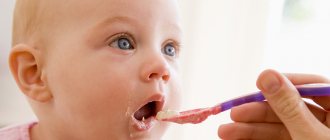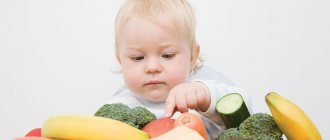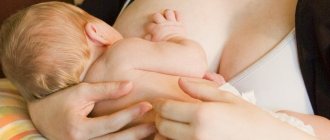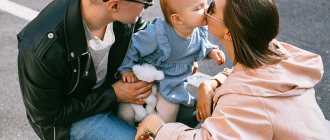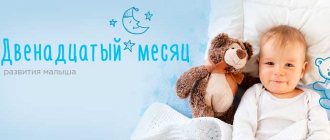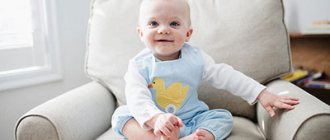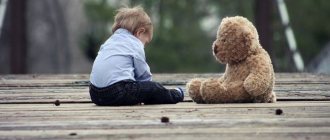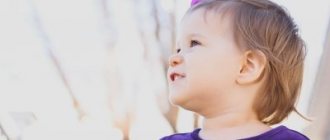How does the child move (general motor development at 1 year and 1 month)
- Your baby will use a lot of energy to learn to walk.
- When a child is learning to walk, soft shoes or bare feet are probably best. Some shoes may be so rigid that a child's foot cannot bend or move while wearing them.
- The baby will learn to roll and kick a ball.
- If there are stairs in your child's environment, he will try to climb them with the help of adults. She will then place both feet on one step before moving on to the next step. Never let her do it alone. Always keep an eye on her near the stairs.
- Always use baby gates or locked doors to protect your child from steps and open windows unless you are there to assist and protect them.
Communication (speech and language development at 1 year and 1 month)
- When your baby points to something, you know it has his attention. Use your words to teach your child to name objects.
- Your baby will learn to point to pictures he recognizes in books, or point to parts of his body if you ask him where they are.
- During this period, your baby will begin to say words for the most familiar things or people in his environment. By 24 months he should know at least 50 words.
- The baby may pronounce the word differently than you. Don't correct him, just repeat the word correctly so he hears it.
- By her second birthday, the little one puts two and three words together to make simple sentences like “Goodbye Mommy” or “I want a cookie.”
Baby study (cognitive development at 1 year and 1 month)
- The baby will spend more time studying the object than before.
- It will be more interesting for your baby to flip through the pages of his favorite books.
- The baby will learn to combine two objects by color, shape or size.
- The baby pays more attention to the actions of others and will try to imitate these actions, for example, feeding his doll from a cup or spoon.
Norms
Your child is now 1.1 years old. And by this age, many changes have occurred. Most children at this age already have 8 teeth. A child's height at 13 months is from 73 to 78 cm for boys, and weight ranges from 9 to 11 kg. Girls are slightly smaller than boys, with an average height of 71 to 77 cm and a weight of 8 to 10 kg. The head circumference of children at 13 months varies from 43 to 48 cm.
Deviation from the above norms to a lesser or greater extent is a reason to consult a doctor, especially if this has not been observed before.
Physical development
Let's look at how a child develops and what he can do at 13 months. After a year, babies do not change so actively in terms of height and weight, as this process slows down a little. That is why it is no longer so important to weigh the baby and measure its growth every month. An exception may be situations when the baby exhibits serious deviations from standard indicators.
At 1 year and 1 month, the child becomes very independent. Most children can walk, and those who have not yet learned to actively crawl on all fours and also walk with their parents by the hand.
By the age of one year, parents should take care of safety in the house. Since from 13 months it is common for a baby to learn everything new, dangerous objects in the house should be inaccessible to the child.
What kids can already do
New baby skills include walking backwards and consciously playing with a ball. Moreover, the baby can kick not only a large ball, but is already able to play with a small one. Children especially love everything unknown, so closed cabinets become the most interesting part of the house. Pulling out clothes and throwing them around is perhaps an activity that is very exciting for children at this age.
A 13 month old baby is very proud of his walking skills. Children of this age category still walk quite funny, but they are quite confident on their feet.
Walks
Try to spend time outside for at least 2 hours a day. You can go out for a walk once, twice, or even three times. The more you are with your baby outside the apartment, the better this will have an impact on the child’s development and health. The mother must understand that at this age the baby is quite curious and inquisitive. Therefore, there is no need to force him to sleep during walks. At this age, you can take a bucket, a shovel, and little beads outside to play in the sandbox.
A 13-month-old child does not walk independently
If after a year the baby still does not attempt to walk independently, then this could be due to the following reasons:
- Heredity.
- The presence of unsuccessful attempts in mastering the first steps.
- Excess body weight of the baby.
- The little one is lazy.
You should not blame yourself or your baby for such a problem. Try to encourage your baby to take the first steps. Use your child’s favorite toys and praise for such purposes. Children of this age especially love balls, and you just need to offer to catch up with the baby as he rolls on the floor.
What should a 13 month old child be able to do?
- The baby knows how to sit at the table independently and makes his first attempts to eat on his own.
- The baby fulfills simple requests, such as: “bring a toy”, “show where the ball is”, and also knows the names of some toys and objects in the house.
- In addition to humming, the baby already knows how to pronounce some syllables. This especially applies to imitation of animal voices (meow, woof, moo-moo and others).
- A child at this age has realized that he can influence objects and is practicing this skill with all his might. Namely: pushing cars, throwing a ball, hiding toys, etc.
- There is little communication with parents for the baby. And he actively begins to reach out to the kids on the playground. And the children of friends and relatives give the baby a wealth of experience related to how to make friends and behave in conflict.
What should a 1 year old child be able to do?
During the first year of life, a person develops intensively not only physically. Sensory, speech, social-communication and self-care skills are being developed.
For example, a one-year-old child recognizes the voices of his parents, pays attention to small objects at a distance of 20-40 cm, distinguishes his favorite toys from others and skillfully handles them. He smiles, rejoices, can sing along and dance to the beat of the music.
Let's look at the main aspects of children's development per year.
Speech and communication
The first speech skills include pronouncing short, simple words, as well as simple sounds to attract attention and get what you want.
Speech skills of a child at 12 months:
- recognizes his name;
- babbles or pronounces the same syllables;
- uses sounds and words meaningfully, relating them to specific objects/persons.
As a rule, one-year-old children know and understand more than 20 words. If a child does not pronounce more than 8-10 words, but tries to repeat new words after his parents, this is also the norm. Pediatrician Evgeny Komarovsky advises monitoring the child’s speech development. If after six months there is an addition to his vocabulary, then everything is fine.
It is also necessary to take into account the factor of heredity: if one of the parents spoke late, there is a chance that his child will also begin to speak later and then catch up with his peers.
It is worth worrying if, between the ages of six and eleven months of life, the child does not pronounce syllables, and at the age of one year he pronounces less than three simple words. These are signs of speech delay and you should consult a doctor.
Communication skills in the case of a one-year-old child are the ability to express their emotions, correctly perceive the information received and, in accordance with this, interact with people around them, literally make contact.
Child at 12 months:
- smiles;
- rejoices at the arrival of relatives;
- recognizes loved ones in photographs;
- imitates the facial expressions of parents;
- cries at the sight of strangers;
- expresses dissatisfaction;
- responds to requests to fetch, carry, open or close;
- can respond to an appeal with a gesture or facial expression;
- understands and knows the difference between “you can” and “you can’t.”
A disorder in a child’s communication skills is evidenced by his limited interests - he plays with only one toy, repeats the same actions - for example, swinging doors, pouring sand/cereals. He seems to be immersed in his own world, and attempts to diversify his activities cause the child to have an attack of aggression or hysteria.
Another alarm bell is problems with nonverbal communication skills. The child cannot establish visual contact and does not understand how to communicate with other people, even if he can speak. All this indicates the possible presence of an autism spectrum disorder.
Independence and self-care skills
Independence in a one-year-old child is just beginning to emerge and actively develop, and improvements in gross and fine motor skills and communication skills contribute to this.
Children discover new possibilities of their body, and at the same time they begin to show initiative, greater perseverance and try to imitate adults.
A one-year-old child can:
- blow hot;
- drink from a glass, holding it with both hands;
- drink from a spoon;
- hold small pieces of cookies or bread and bite them;
- towel;
- ask to go to the toilet;
- remove unfastened shoes;
- help dress yourself by moving your arms and head.
Neuropsychic development
The development of a child at 13 months is determined by the acquisition of new qualities. The baby wants to be the center of attention. And when the parents are busy with something, the baby willingly tries to help. Most often this concerns cleaning or cooking.
You shouldn’t stop your child’s initiative, even if he bothers you. The child wants to be useful to adults, and prohibitions and irritability on the part of the parents will only discourage him from all desire for such activities in the future.
How to properly develop a baby
The main thing that a child needs to develop at this age is the ability to interact with other children. And also organize the right speech environment, introduce the child to music, drawing, fairy tales and books. Don’t forget about the development of gross and fine motor skills.
Give your child new ideas for old games, as the lack of variety can get boring. For example, don’t just drive a car with him, but have a race. Show him how to play with new toys. The baby will learn this very quickly and will continue to do it himself. Please note that by forcing your baby to do something, you can discourage him from doing it at all.
In order to properly develop the baby, it is necessary to conduct special games and activities with him. But after a year, the child can already play independently, so parents can leave him with toys for a while. Playing alone becomes the baby's leading activity.
In the physical direction
Develop your baby's walking skills. Encourage him to try to walk in a straight line. Don't miss the opportunity to teach your child to overcome obstacles. For example, climbing a curb or step. Collect toys with him. This will help you practice gross motor skills.
To develop fine motor skills, invite your little one to assemble a pyramid from rings or make a tower from cubes. A very good exercise is pouring cereal or pasta from one container to another. But here you need your constant supervision so that the little one doesn’t start trying them. Attach clothespins to a pillow or soft toy and let your child remove them. Development will be successful only if there is constant contact and communication with the baby.
Mental capacity
It is very important to develop the baby’s speech abilities at this age. And for this, parents need to constantly communicate with him. Comment on any of your actions for your child. Be sure to name the body parts and tell them what you do with them. Together with the baby, look at the books and describe what is drawn in them. It is very effective to develop a child’s speech skills through the study of short rhymes.
It's also time to start studying forms and properties. Take a simple shaped children's toy and name it. For example, a ball or a cube. Then tell us what you can do with them. You can teach your toddler to use paints, pencils or crayons.
Baby's vocabulary at 13 months
Some children already begin to master spoken language after a year. Of course, the vocabulary is still very small. The norm for 13 months is 10 words. In practice, children speak less. There is nothing wrong with this, but it is very important to communicate with your baby. Be sure to read fairy tales to him, recite rhymes and talk to him as often as possible.
To determine how well your child is learning the information he hears, take the following test. Ask your child to bring something from the toys, identifying the object by its name. When a child is 1 year 1 month old, he already knows the names. And accordingly, he should easily fulfill your request.
Don't worry too much if your baby hasn't started talking after a year. It is quite possible that this is due to individual developmental characteristics. Of course, it may be that adults spend too little time on this issue, namely, they rarely or talk too quickly with the child.
To stimulate the development of this skill, parents need to talk with their child often, try to regularly comment on what is happening and read fairy tales before bed.
What to do to ensure that your child develops correctly
How can you support your baby's development at 13 months?
- Read together every day
. Reading aloud before bed or throughout the day can be a joy for both parents and little ones, eventually becoming one of your favorite activities to do together that is beneficial for intellectual development. Look at the pictures together, name the child the animals and objects he points to, help him turn the pages. Around this age, children sometimes choose the book they want you to read and make the animal sounds in the pictures.
- Choose toys that promote hand-eye coordination and motor skills
. Give your baby blocks and soft toys. He will be pleased that he is better able to grasp and hold objects with his thumb and forefinger.
- Talk to your child
. Few babies are eloquent at 13 months, but this should not stop you from having conversations with your baby, because this is useful for the development of his speech. Tell your child what is happening around him and what you are doing during walks, in the bathroom, in the car, and even when changing a diaper. Speak in your normal “adult” voice.
- Wean your baby off the bottle (if you haven't already)
. If your baby still drinks from a bottle, it’s time to introduce him to a cup with a sippy cup. Experts recommend switching completely to drinking from a cup by 18 months. Try removing the bottle gradually: first during the day, then in the morning and evening, and finally before bed.
Nutrition
When a child is 1 year 1 month old, many parents mistakenly believe that it is too early to transfer him to the common table. The main mistake in the diet is ground porridge, vegetable and fruit purees. It is very important to prepare food for your baby, leaving some of it not completely ground (small pieces). The child must master chewing skills and also learn to distinguish the tastes of foods.
After a year, you can stop breastfeeding and replace breast milk with regular foods. It is very important not to forget to give your baby something to drink regularly. These can be juices, compotes and water.
A child's diet at 13 months allows fish and meat to be included in the diet. These products have a beneficial effect on mental and physical development. After one year, the baby should already have his own personal dishes, cutlery and high chair.
Protect your child from sweets, as at this age it is undesirable for him to try them. Fruits are much healthier and tastier.
It is very important to prepare meals for your baby from fresh ingredients. It is advisable that these are trusted stores and manufacturers. Never cook food with artificial additives.
The most suitable methods for preparing baby food are boiling, steaming and stewing. Vegetable oil can be added to vegetable and meat purees, but fried foods are not allowed for the baby yet, since the digestive system is not yet perfect enough.
One of the important dishes for a growing body is porridge. It is best offered to the baby for breakfast. You can gradually switch to well-boiled porridge, instead of the usual mashed puree.
Regular consumption of fermented milk products is very important. The daily intake of kefir is about 200 ml, and cottage cheese no more than 70 grams. It is very important that dairy products are fresh, of high quality and without artificial fillers.
An excellent option for lunch would be vegetable and meat puree. You can use pumpkin, tomatoes, potatoes, carrots and zucchini.
It is advisable for every mother to think through the menu in advance for the week.
Nutrition for a one-year-old child
In a year and a month, the child eats five times a day. Some children are already switching to four meals a day. The diet should consist of dairy products, vegetables, cereals, and meat. At this age, you can safely add raw vegetable salads to the menu, made from cucumber, grated carrots, and peeled tomatoes. The milk allowance for a baby is 700 ml, including the milk used for cooking. He should eat 85 grams of meat. The egg is not yet given as a whole egg; only the yolk is added to dishes. Your baby should not be fed cereal more than once a day.
At the beginning of the second year of life, children already know how to chew quite well. Therefore, they can be given bread, chopped meat, and not just pureed dishes. It is advisable to forget about the pacifier; it forms an incorrect bite and slows down the development of chewing skills. It is recommended to give protein products and meat to the child in the first half of the day, as they take longer to digest. In the evening you can feed him porridge or vegetable puree. Here is an approximate menu for a baby at one year and a month:
- Morning meal. Steam omelette, porridge with milk, bread and butter, tea
- Dinner. Mashed borscht, steamed chicken soufflé, mashed potatoes
- Afternoon snack. Grated apple, unsweetened cookies, natural yogurt
- Evening meal. Cottage cheese casserole, milk, a piece of bread with butter.
Each child has his own taste preferences. When creating a menu, they must be taken into account. During the year and month, sweets and chocolate are still contraindicated for children; they cannot be given smoked sausage, various canned foods and marinades. After a year, you can try citrus fruits in small portions to avoid allergies. The same applies to fish; it is advisable not to include it in your diet more than once a week. It is better to prepare mixed vegetable puree, including carrots, zucchini, pumpkin, broccoli and cauliflower. If your child likes it, you can give him small pasta with butter or milk.
Dream
A child's routine at 13 months is based on the correct daily routine. Children of this age category tend to divide their night sleep into 2 parts. During the day, babies also sleep 2 times, at least one hour each. Rest at night takes from 10 to 13 hours.
At the age of 1 year 1 month, children can be divided into several types, depending on the frequency and duration of sleep:
- Larks usually go to bed around 8–10 pm and wake up at 4–5 am. Then they begin to become active or ask for the breast.
- Owls go to bed by 11 pm and wake up around 7 am.
- Pigeons do not have a clear rest schedule. And it is most difficult for parents of such children to bring the regime back to normal.
Development of intelligence and social skills in a child
A child intensively develops his speech every year and a month. He can already pronounce individual words. Basically they consist of two identical syllables - “mama”, “dad”, baba”, “didi”. He can imitate the voices of animals, designating animals in this way. For example, he calls a dog “av-av”, a cow – “mu-mu”. Often the baby can only pronounce a stressed syllable, and thus gives names to certain objects. He calls the table “to,” the cube “ku,” the spoon “lo,” and the cat “ko.” Since he clearly associates these syllables with specific things, they can be conventionally called the first words. The child also learns verbs; he says “give” if he wants to get something or “yama” when he wants to eat. Moreover, some children have more names of objects in their vocabulary, while others have more symbols of actions.
The child acquires more and more speech
After a year, children learn to make their first generalizations. They identify some characteristic feature in a particular object, and begin to call all other similar things that way. For example, everything round can be a ball, all animals can be called kitties or “aw-aw”. Children and actions unite. Everything related to food is called “yum-yum”; moving objects can be called “beep”. The baby's passive vocabulary is much larger than the active one. He understands his parents quite well. He can react to the words “walk” or “swim” with joy or whims, depending on his mood. If the baby is asked to bring something, he easily finds it. Understands the word “impossible”, although he doesn’t always listen.
No less important for a child of the second year of life are social skills that actively develop after a year. He is no longer so attached to his mother, he clearly separates his own “I”, and can play in the room by himself. But the fears have not gone away; when the mother is gone for a long time, the baby can easily cry. Still wary of strangers. If at home the little one feels like the master of the situation, then on the street, when he sees a stranger, he tries to be closer to his mother. The child begins to be interested in his peers, he tries to get to know them and play. Often one-year-old children begin to exchange toys, talk to each other in their own language, and sometimes fight.
Developmental activities
Games help accelerate the development of the baby. At this age, it is necessary to constantly monitor the child; you cannot leave him alone even for a short period of time.
Don’t be afraid to take your child at this age to shopping centers, parks, and various playgrounds. Of course, it is important to follow safety precautions. The impressions that a child will receive from such walks can engage their investigative instincts and also teach them not to be afraid of the new and unknown.
Educational toys for children from one year old:
- Books with bright and clear images.
- Talking books, singing children's tablets.
- Large toys that you can push and carry around.
- Gurneys with flashing lights that make sounds.
Plastic puzzles will be effective activities aimed at developing a child at 13 months of age. These are special cubes with separate figures and ready-made slots for them. Let the child try to distribute the elements correctly.
For children after one year old, playing with a piggy bank is considered a very exciting activity. They really enjoy throwing coins through the hole, listening to the tinkling sound that is made at the bottom of the piggy bank.
Playing hide and seek with a toy is also one of the favorite activities of kids of this age group. Hide the toy and invite the baby to find it. And when he finds it, praise and admire such a wonderful result.
Water treatments
At 13 months, the child is already accustomed to the fact that every morning he wakes up, then goes to the bathroom, where he washes himself and brushes his teeth. It is important to explain to the baby that this is not just a daily duty, but a very necessary and useful procedure.
In this age category, children love to splash around in the bathtub and play with some water. Therefore, there are usually no difficulties in bathing the baby. Some parents believe that it is necessary to start toughening up their children at this age. And gradually reduce the temperature when bathing the baby to 28 degrees.
When using special products for bathing, washing your baby’s hair, do not forget that you need to choose cosmetic products after taking a bath. This will prevent dryness and flaking on the baby's delicate skin. As soon as you see that the child is trying to wash himself, try to support his initiative, but with mandatory control over his actions.
Attention! If you notice significant deviations from the norms that reflect the correct development of a child at 13 months, you should consult your pediatrician.
